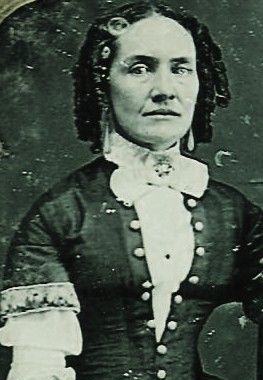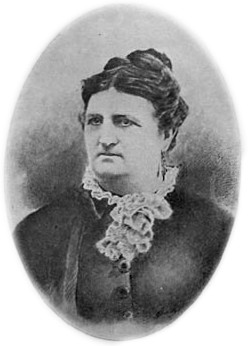María Ygnacia López de Carrillo facts for kids
Quick facts for kids
María Ygnacia López de Carrillo
|
|
|---|---|
 |
|
| Born | January 31, 1793 |
| Died | February 28, 1849 (aged 56) |
Doña María Ygnacia López de Carrillo (born January 31, 1793 – died February 28, 1849) was an important woman from early California. She was known as a ranchera, which means she managed a large ranch. She is famous for founding the city of Santa Rosa. She married into the well-known Carrillo family of California and became the ancestor of many important people in California's history.
Contents
The Story of Ygnacia Carrillo
Ygnacia was born on January 31, 1793. She was given the name Maria Ygnacia de la Candalaria Lopez when she was baptized. This happened in the chapel of the Presidio of San Diego, which was like a fort. Her father was a soldier there. Her mother, Maria Feliciana Arballo, traveled with a famous journey called the Anza Expedition. Ygnacia's father passed away when she was only seven years old.
On September 3, 1809, Ygnacia married Joaquin Victor Carrillo. He was a soldier and part of the important Carrillo family. Ygnacia and Joaquin had thirteen children together, and twelve of them grew up to be adults. Many of their children played big roles in the early history of California.
Around 1821, the family got a special house. Francisco María Ruiz, who was in charge of the Presidio of San Diego, built them an adobe home. An adobe is a building made from sun-dried earth bricks. They lived there for over ten years. A part of this old house, called "Casa de Carrillo," can still be seen today.
After Joaquin passed away around 1836, Ygnacia and her nine children who were still at home traveled north. They went over 500 miles in an ox-cart to Sonoma. There, they stayed with her son-in-law, Mariano Guadalupe Vallejo.
In 1838, Ygnacia received permission from Vallejo to settle in an area north of Sonoma, near Santa Rosa Creek. Her sons, with help from local native people and her son-in-law Salvador, built a large adobe house. This house is now known as the "Carrillo Adobe."
In 1841, the governor at the time, Manuel Jimeno, officially gave her the land. She received 8,885 acres, which was called the Rancho Cabeza de Santa Rosa. This was very special because it was one of the few land grants in California given to a single woman.
Ygnacia was in charge of the farming on her ranch. They grew many crops like wheat, barley, oats, corn, beans, and different kinds of melons. Her son Ramon managed the animals. They had a lot of livestock, including 1,500 horses, 3,000 cattle, and many sheep. Ygnacia also learned to speak the language of the native people living in the area.
During the Bear Flag Revolt in 1846, some of her family faced trouble. Her son Julio and two of her sons-in-law were put in prison at Sutter's Fort. The rancho's animals, weapons, and food supplies were taken away.
In 1849, Ygnacia passed away. This was just a year after Mexico gave California to the United States. She was buried in the chapel of the Mission San Francisco de Solano in Sonoma.
The Historic Carrillo Adobe
The Carrillo Adobe is a very old and important building. A small church outpost, called Assistencia Santa Rosa de Lima, was started on this site around 1829. However, the project was stopped because of changes in how missions were run.
After Ygnacia passed away, her son-in-law David Mallagh opened a trading post and a tavern in the adobe. Santa Rosa's very first post office was also located in this adobe building. The trading business continued with different owners until the 1860s. Later, the land was bought by Gustav Hahman, who turned it into an orchard.
In 1950, Archbishop John Joseph Mitty bought the land. He planned to build the Cathedral of Saint Eugene and a school there. The Diocese of Santa Rosa put a fence around the old adobe ruins. They also planned to fix it up, but these plans never happened.
When the adobe was studied in 1962, only a three-room structure remained. It was 83 feet long and 21 feet wide, with a 10-foot porch all around.
In 2005, the City of Santa Rosa gave a developer permission to build up to 165 homes on the land. The developer also agreed to spend over $300,000 to protect the adobe from further damage. In 2006, archaeologists found that the adobe was built on strong stone foundations. In 2012, some vandals broke through the fence and stole wooden posts and beams. These were later found nearby.
Today, the ruins of the Carrillo Adobe are still visible. They are protected by a metal roof and a pole structure. You can find them behind the Cathedral of Saint Eugene. This is near the corner of Montgomery Drive and Franquette Avenue in Santa Rosa.
Ygnacia's Family and Legacy
Ygnacia and Joaquin had many children who became important figures in California's history.
Daughters
- Maria Antonia Natalia "Josefa" (born November 27, 1810 – died January 1893) was Ygnacia's oldest daughter. In 1829, she ran away to Valparaíso to marry Henry D. Fitch. He was a sea-captain from Massachusetts. They had eleven children. In 1841, Fitch was given Rancho Sotoyome, which was north of Rancho Cabeza de Santa Rosa.
- María Ramona de Luz (born July 1812 – died December 1888) married Captain José Antonio Romualdo Pacheco. He was a soldier from Guanajuato. He was killed in 1831 during a battle. She was given Rancho Suey near what is now Santa Maria, California that same year. Later, she married Captain John D. Wilson, who was from Scotland.
- Maria de la Luz Eustaquia (born May 18, 1813 – died May 18, 1890) married Jose Manuel Salvador Vallejo. He was the younger brother of General Mariano Guadalupe Vallejo.
- Francisca Maria Felipa Benicia (born August 23, 1815 – died January 30, 1891) married General Vallejo himself on March 6, 1832. The city of Benicia was named after her. In 1834, Vallejo was given Rancho Petaluma, which was south of Rancho Cabeza de Santa Rosa.
- Maria Marta (born July 29, 1826, died October 1905) married Jose Joaquin Victor Carrillo Montano in 1855 in Santa Rosa.
- Juana de Jesús "Juanita" (born March 1829) married David Mallagh, an Irish sea-captain, in 1850.
- Maria Felicidad de la Augusta (born March 1833 – died July 23, 1856) married Victor Castro.
Sons
- Joaquín Victor II (1820 – 1899) was Ygnacia's oldest son. He was chosen as mayor of Sonoma in 1846. He was also imprisoned during the Bear Flag Revolt. He was given Rancho Llano de Santa Rosa, west of Rancho Cabeza de Santa Rosa. He fought in the Battle of Olómpali in 1846.
- Juan Bautista died in 1841.
- Jose Ramon (born February 1821 – died May 1864) sold the Casa de Carrillo house. Later, he fought in the Battle of Olompali and the Battle of San Pasqual. He married Vicenta Sepulveda de Yorba in February 1847.
- Jose de los Dolores (born 1824).
- Julio Maria Tomas (1824 – 1889) was put in prison at Sutter's Fort in 1846. This happened after he tried to deliver a message to his brothers-in-law. After Ygnacia passed away, he inherited most of the Rancho Cabeza de Santa Rosa.
- Jose de la Luz (born February 27, 1831 – died March 7, 1831) died when he was a baby.
Grandchildren
- José Antonio Romualdo Pacheco, Jr. (born October 31, 1831 – died January 23, 1899) was the son of Maria Ramona and her first husband, Romualdo Pacheco. On February 27, 1875, he became the twelfth governor of California. He was the first governor born in California and the first of Mexican heritage.
Places Named After Her
- Maria Carrillo High School is a public school in Santa Rosa. It was named after her and opened in 1996.




